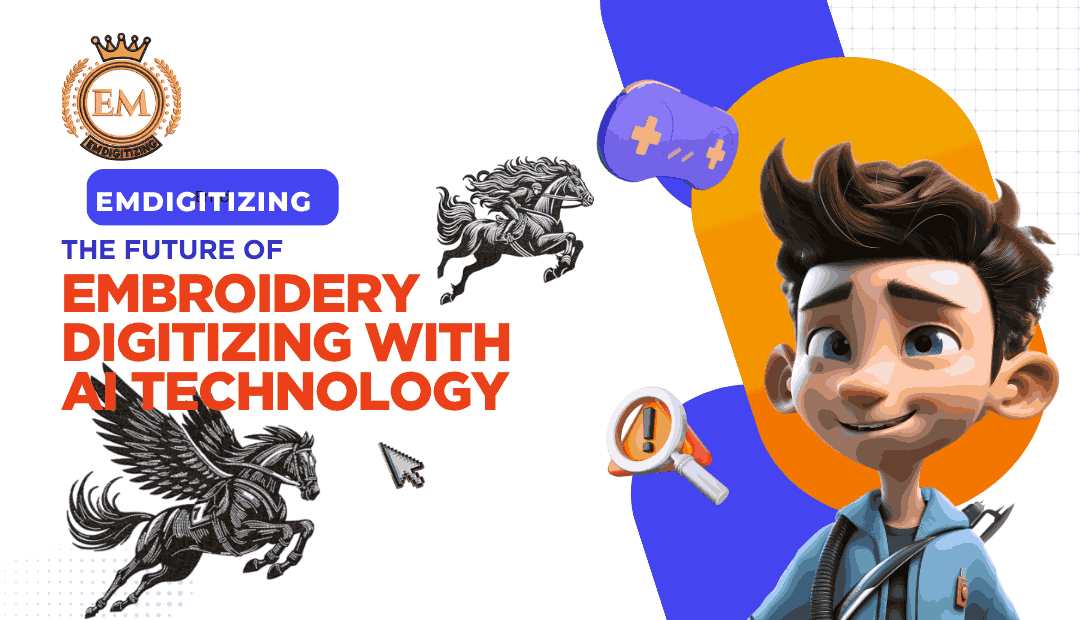Embroidery digitizing has come a long way from the days of manual design work and limited software tools. Today, advanced technologies are changing the industry at a rapid pace, and artificial intelligence (AI) is at the center of this transformation. As the demand for precision, speed, and custom design continues to grow, AI is offering new possibilities for designers, businesses, and digitizing service providers.
In this blog, we will explore how AI is influencing the world of embroidery digitizing, the benefits it brings, and what the future may look like for designers and brands.
What Is AI in Embroidery Digitizing?
Artificial Intelligence in embroidery digitizing refers to the integration of smart algorithms and machine learning into digitizing software and processes. It allows software to analyze images, identify patterns, assign appropriate stitch types, and even correct errors in design with minimal human input.
Unlike traditional methods that rely heavily on manual decision-making, AI-driven systems can learn from previous digitizing files, adjust stitch settings based on fabric type, and improve accuracy through predictive modeling.
How AI Is Transforming Embroidery Digitizing
1. Automated Stitch Mapping
One of the key features AI brings to embroidery digitizing is automated stitch mapping. Traditionally, digitizers had to manually define each stitch area and select appropriate stitch types. With AI, software can automatically recognize elements in the image and apply suitable stitch paths with precision.
This not only reduces the time needed for digitizing but also lowers the chances of human error.
2. Improved Accuracy in Stitch Conversion
AI-powered digitizing tools are trained on thousands of embroidery files, which helps them make smarter decisions. For example, if you’re digitizing a logo with small text, AI can determine the most efficient stitch type and density to maintain clarity without compromising quality.
The result is consistent, professional-looking designs even with minimal user input.
3. Adaptive Learning from User Preferences
Modern AI systems are capable of learning from user behavior. If a digitizer frequently adjusts density settings or changes stitch types in a particular way, the AI software can begin to anticipate those preferences and apply them automatically in future projects.
This personalization speeds up workflow and ensures that every design aligns with the user’s preferred style and quality.
4. Automatic Error Detection and Correction
AI can identify common issues such as stitch gaps, thread breaks, or overlaps before the design is sent to the embroidery machine. Instead of finding out during the stitch-out phase, users can fix problems in the digitizing stage, saving time, thread, and fabric.
AI-powered quality checks are especially useful for beginners and help avoid costly mistakes.
5. AI Integration in Embroidery Machines
Some newer embroidery machines come with built-in AI functions. These machines can:
-
Auto-detect fabric types
-
Adjust thread tension
-
Recommend hoop sizes
-
Notify users of potential issues before starting a stitch run
These advancements take digitizing beyond the screen and into the machine itself, making the entire embroidery process more intelligent and user-friendly.
Benefits of AI in Embroidery Digitizing
Speed and Efficiency
AI dramatically cuts down the time needed to digitize complex designs. What once took hours can now be completed in minutes, which is a major advantage for commercial embroidery businesses.
Lower Skill Barrier
Beginners can now create professional-quality designs using AI-powered tools without needing years of experience. The software handles the technical parts, allowing users to focus on creativity.
Cost Reduction
By reducing errors and minimizing revisions, AI helps lower operational costs. Businesses no longer need to rely exclusively on high-priced experts for every design, which increases profit margins.
Scalability
For companies that deal with high volumes of embroidery work, AI makes it easier to handle large orders with consistency and speed. This scalability is essential for custom apparel brands and uniform suppliers.
Challenges and Considerations
Despite its benefits, AI in embroidery digitizing is not without challenges.
Quality vs Automation
While AI is capable of automating a lot, some complex or artistic designs still benefit from human touch. A fully automated process might not capture the subtle details that a skilled digitizer would.
Learning Curve
Though AI simplifies many processes, users still need to understand basic embroidery principles to make adjustments or fix unexpected results.
Software Costs
High-end AI-powered digitizing software often comes with a hefty price tag. Smaller businesses may find it difficult to invest unless the return justifies the cost.
The Future Outlook
As AI continues to evolve, we can expect even more powerful and intuitive tools in the embroidery world. Here are a few possibilities for the future:
AI-Generated Embroidery Designs
Instead of just converting existing images, AI may soon be able to generate entirely new embroidery designs based on prompts or themes. Imagine typing “vintage floral for baby onesie” and getting a ready-to-use digitized design within seconds.
Real-Time Stitch Simulation with AI Feedback
Future tools may provide real-time simulations where AI not only shows how the design will stitch out but also gives live suggestions to improve stitch flow, reduce thread waste, and enhance visual balance.
Voice-Controlled Digitizing
As voice assistants become more advanced, digitizers may soon be able to say commands like “change fill type to tatami” or “increase density by 10 percent” without clicking through menus.
Cloud-Based Collaborative Platforms
AI-enabled digitizing platforms may allow multiple designers to work on a single file in real time, making collaboration easier for design teams and agencies.
Why It Matters for Embroidery Businesses
For businesses, staying updated with the latest digitizing technologies is not just about improving efficiency. It’s about staying competitive in a fast-paced market.
Customers today expect fast delivery, perfect detailing, and consistent quality. AI makes it easier to meet these demands while freeing up human talent for creative work. Many businesses already rely on the best embroidery digitizing services that use AI-backed tools to deliver exceptional results faster than ever.
Those who adapt early are likely to lead the market, while others may struggle to keep up with changing expectations.
Conclusion
AI is set to revolutionize embroidery digitizing in ways we are only beginning to understand. From automating complex processes to personalizing user workflows and improving final stitch quality, artificial intelligence is proving to be a powerful asset for both newcomers and industry veterans.
As more tools become available and hardware continues to evolve, the gap between design and production will keep shrinking. The future of embroidery digitizing with AI is not only promising but also inevitable. Embracing it now can set the foundation for growth, efficiency, and success in the embroidery industry.
Frequently Asked Questions (FAQs)
Q1: Can AI completely replace human digitizers?
AI can handle most of the technical aspects, but human creativity and experience are still valuable, especially for complex or artistic designs.
Q2: Are AI-based digitizing tools suitable for beginners?
Yes, many AI-powered software programs are designed to assist beginners by automating the harder parts of digitizing.
Q3: How expensive are AI-based digitizing tools?
Prices vary widely. Some tools offer monthly subscriptions, while others require one-time payments. The investment depends on your needs and business size.
Q4: Will AI reduce the need for professional digitizing services?
Not necessarily. While AI makes digitizing more accessible, many clients still prefer expert services for high-quality, custom results.
Q5: What skills should I still learn if I use AI tools?
Understanding stitch types, fabric behavior, and machine formats will always be helpful, even if you’re using AI-powered tools.

